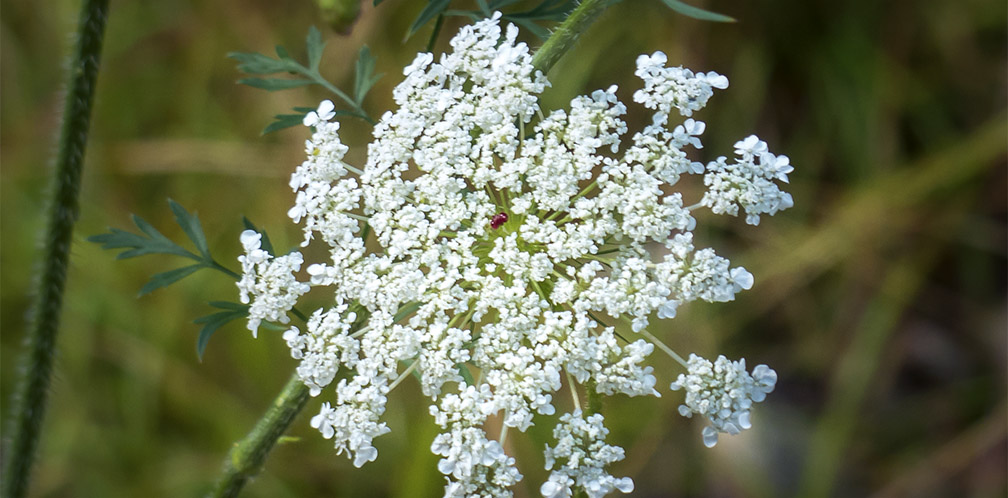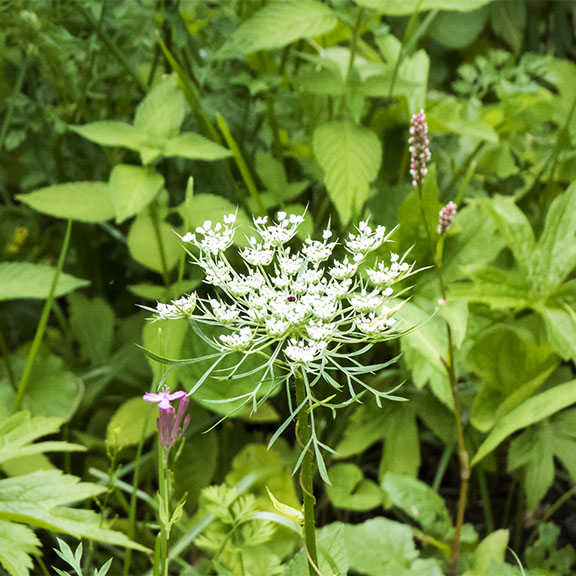Wildflowers of the Adirondacks:
Queen Anne's Lace (Daucus carota)

Queen Anne's Lace (Daucus Carnota) is a nonative wildflower with feathery leaves and clusters of tiny white flowers that bloom in summer. It is a member of the Carrot Family (Apiaceae) and the ancestor of the garden carrot. There are conflicting theories on the origin of the common name. Some accounts claim that the plant traces its name to Queen Anne, who apparently liked to wear lacy medallion patterns resembling the flower head disk. Other accounts trace the name to Saint Anne, the patron saint of lace-makers.
This plant is also known as Wild Carrot, Bee's Nest-plant, Devil's Plague, and Bird's-Nest, The latter name refers to the fact that, when mature, the umbrella-like cluster curls inward, resembling a bird's nest.
Queen Anne's Lace is not native to the Adirondacks or to North America. It reportedly originated in Afghanistan and adjacent areas and spread to Mediterranean Europe before the Christian era. This plant was apparently introduced in North America as a medicinal herb.
- Queen Anne's Lace is listed as a Noxious Weed in Michigan and Washington, a Prohibited Noxious Weed in Ohio, and a Secondary Noxious Weed in Iowa.
- Queen Anne's Lace does not appear on the Federal Noxious Weed List.
- Queen Anne's Lace does not appear among the species profiles provided by the National Invasive Species Information Center.
- The New York Invasive Species Clearinghouse does not include it on its list of nonnative plant species.
- Queen Anne's Lace is not listed among species of concern by the Adirondack Park Invasive Plant Program.
Identification of Queen Anne's Lace

Queen Anne's Lace is an erect plant that grows one to three feet tall. The stem is covered with bristly hairs and is vertically veined. The leaves are alternate and compound. They are two to eight or ten inches long and several inches wide, with the leaflets divided into narrow segments, giving the plant a lacy or fern-like appearance.
Queen Anne's Lace produces flat clusters of tiny white flowers perched on the top of a long, naked stalk.
- The clusters are 2 to 5 inches wide. The flat clusters (umbels) consist of 20-90 umbellets, each of which has 15-60 flowers.
- The flowers are tiny, about 1/8 inch across, with five petals, five white stamens, and a pair of white styles. The edge flowers may be enlarged and sometimes irregular.
- The flower cluster often has a tiny dark purple floret near the center.
Its function of the dark florets in the middle of the cluster remains a mystery. One hypothesis is that the contrasting color is designed to attract pollinating insects, but this has not been corroborated by experiments, which reveal that most insects do not have a preference for clusters with a purple central floret.
One plant can produce numerous flower clusters. There are three-forked, stiff, leaf-like bracts growing beneath the cluster. As the flower cluster ages, it curls to form a nest-like shape. Queen Anne's Lace usually blooms in this part of the Adirondack Park from late June through late August or early September, depending on the weather.
The fruit of Queen Anne's Lace consists of two-segmented, light reddish-purple fruits which change to green to grayish brown before splitting into two one-seeded segments. The fruit is seed-like and bristly.
Uses of Queen Anne's Lace
Queen Anne's Lace is said to be edible when young, when it reportedly has been used as a cooked vegetable. However, Queen Anne's Lace is very similar in appearance to deadly poisonous members of the carrot family, such as Poison Hemlock, which may cause paralysis and death. As a result, most authorities recommend strict avoidance. In addition, contact with Queen Anne's Lace may cause allergic reaction, including dermatitis and blisters.
Similar cautions apply to this plant's use as a medicinal herb, although the plant was used for medicinal purposes by several native American tribes. For example, Queen Anne's Lace was reportedly used by the Cherokee as a dermatological aid. The Delaware used an infusion of fresh blossoms to treat diabetes. The Iroquois used a decoction of roots to treat blood disorders.
Wildlife Value of Queen Anne's Lace
As a food source, Queen Anne's Lace (despite its abundance) is of minor importance for small mammals and terrestrial birds, providing an estimated 2-5 percent of their diets. The seeds may be eaten by the Woodland Vole, Ruffed Grouse, and American Goldfinch. Queen Anne's Lace is of no importance to large mammals and water birds and does not provide cover for any of them.
Queen Anne's Lace is of somewhat more importance to selected insects. Its nectar and pollen attracts small bees, wasps, flies, and beetles. A number of insects feed on the foliage and roots. Examples include the Carrot Beetle and the larvae of both the Black Swallowtail butterfly and the Carrot Seed Moth.
Distribution of Queen Anne's Lace
Queen Anne's Lace can be found throughout the lower forty-eight states, as well as the southern provinces of Canada. It is found in most New York counties, including most counties within the Adirondack Park Blue Line. It has not been vouchered in Oneida or Saratoga counties.
Habitat of Queen Anne's Lace
Queen Anne's Lace grows in dry, sunny areas and disturbed sites, roadsides, open fields and meadows, and woodland edges. In the Adirondack Mountains, it is found in at least two ecological communities: Calcareous Pavement Woodland and Successional Old Field. The latter is a meadow that occurs on areas that were once cleared for farming or development and then abandoned. Look for Queen Anne's Lace growing near Common Chickweed, New England Aster, and hawkweeds.
Several of the trails highlighted here traverse successional fields, where you are likely to find Queen Anne's Lace. This includes the Old Orchard Loop at Heaven Hill and several of the John Brown Farm trails. In addition, Queen Anne's Lace may be seen at the Paul Smiths VIC along the open sections of the Esker Trail, Silvi Trail, and Skidder Trail; the upper section of the Jenkins Mountain Trail; and the open, western sections of the Woods and Waters Trail and Logger's Loop Trail. Queen Anne's Lace is common and abundant along roadsides (like the Adirondack Loj Road) and the edges of wide, sunny trails throughout the Adirondacks.
References
Michael Kudish. Adirondack Upland Flora: An Ecological Perspective (The Chauncy Press, 1992), p. 178.
New York Flora Association. New York Flora Atlas. Wild Carrot. Daucus carota L. Retrieved 14 August 2021.
United States Department of Agriculture. The Plants Database. Queen Anne's lace. Daucus carota L. Retrieved 5 November 2017.
NatureServe Explorer. Online Encyclopedia of Life. Wild Carrot. Daucus carota - L. Retrieved 6 November 2017.
Native Plant Trust. Go Botany. Wild Carrot. Daucus Carota. Retrieved 14 August 2021.
New York State. Department of Environmental Conservation. New York Natural Heritage Program. Ecological Communities of New York State. Second Edition (March 2014), pp. 96-97, 103-104. Retrieved 17 October 2015.
New York Natural Heritage Program. 2021. Online Conservation Guide for Calcareous Pavement Woodland. Retrieved 14 August 2021.
iNaturalist. Queen Anne's Lace. Daucus carota. Retrieved 14 August 2021.
iNaturalist. Adirondack Park Observations. Queen Anne's Lace. Daucus carota. Retrieved 14 August 2021.
USA National Phenology Network. Nature’s Notebook. Daucus carota. Retrieved 6 November 2017.
Connecticut Botanical Society. Queen Anne's Lace. Daucus carota L. Retrieved 6 November 2017.
University of Wisconsin. Flora of Wisconsin. Daucus Carota L. Retrieved 6 November 2017.
Minnesota Wildflowers. Daucus carota (Queen Anne's Lace). Retrieved 6 November 2017.
Illinois Wildflowers. Wild Carrot. Daucus carota. Retrieved 6 November 2017.
Online Encyclopedia of Life. Wild Carrot. Daucus carota. Retrieved 6 November 2017.
Anne McGrath. Wildflowers of the Adirondacks (EarthWords, 2000), p. 20, Plate 4.
Roger Tory Peterson and Margaret McKenny. A Field Guide to Wildflowers. Northeastern and North-central North America (Houghton Mifflin Company, 1968), pp. 48-49.
Lawrence Newcomb. Newcomb's Wildflower Guide (Little Brown and Company, 1977), pp. 220-221.
David M. Brandenburg. Field Guide to Wildflowers of North America (Sterling Publishing Company, Inc., 2010), p. 565.
Timothy Coffey. The History and Folklore of North American Wildflowers (FactsOnFile, 1993), pp. 154, 158.
Ruth Schottman. Trailside Notes. A Naturalist's Companion to Adirondack Plants (Adirondack Mountain Club, 1998), p. 81.
Wilbur H. Duncan and Marion B. Duncan. Wildflowers of the Eastern United States (The University of Georgia Press, 1999), p. 60, Plate 220.
National Audubon Society. Field Guide to North American Wildflowers. Eastern Region. (Alfred A. Knopf, 2001), pp. 340-341, Plate 159.
William K. Chapman et al. Wildflowers of New York in Color (Syracuse University Press, 1998), pp. 18-19.
Alexander C. Martin, Herbert S. Zim, and Arnold L. Nelson. American Wildlife & Plants. A Guide to Wildlife Food Habits (Dover Publications, 1951), pp. 412-413.
John Eastman. The Book of Field and Roadside: Open-Country Weeds, Trees, and Wildflowers of Eastern North America (Stackpole Books, 2003), pp. 229-232.
Plants for a Future. Daucus carota - L. Retrieved 7 November 2017.
Steven Foster and James A. Duke. Medicinal Plants and Herbs of Eastern and Central North America (Houghton Mifflin Harcourt, 2014), pp. 69-70.
Lee Allen Peterson. A Field Guide to Edible Wild Plants. Eastern and Central North America (Houghton Mifflin Company, 1977), pp. 38-39.
University of Michigan. Native American Ethnobotany. A Database of Foods, Drugs, Dyes and Fibers of Native American Peoples, Derived from Plants. Daucus carota L. Retrieved 7 November 2017.
Canadian Biodiversity Information Facility. Butterflies of Canada. Black Swallowtail (Papilio polyxenes). Retrieved 7 November 2017.
Iowa State University. BugGuide. Carrot Seed Moth. Sitochroa palealis. Retrieved 7 November 2017.
Iowa State University. BugGuide. Megacerus discoidus. Retrieved 7 November 2017.
Allen J. Coombes. Dictionary of Plant Names (Timber Press, 1994), p. 57.
Information on Non-native Plants
United States Department of Agriculture. Federal Noxious Weed List. Retrieved 14 August 2021.
National Invasive Species Information Center. Invasive Species Profiles List. Retrieved 14 August 2021.
New York Invasive Species Clearinghouse. New York Invasive Species (IS) Information. Retrieved 14 August 2021.
Adirondack Park Invasive Plant Program. Species of Concern. Retrieved 14 August 2021.
Wildflowers of the Adirondack Park
